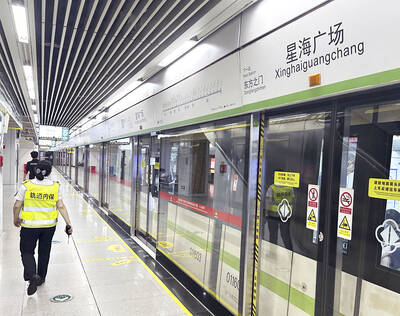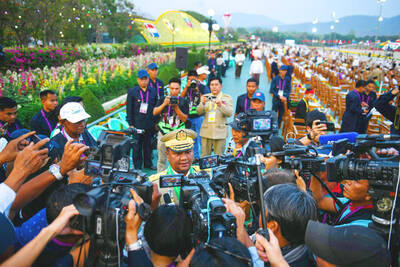The world’s mega-cities are merging to form vast “mega-regions” which may stretch hundreds of kilometers across countries and be home to more than 100 million people, a major UN report said.
The phenomenon of the “endless city” could be one of the most significant developments — and problems — in the way people live and economies grow in the next 50 years, said UN-Habitat, the agency for human settlements, which identified the trend of developing mega-regions in its twice-yearly State of World Cities report.
The largest of these, said the report, which was launched yesterday on Monday at the World Urban Forum in Rio de Janeiro, is the Hong Kong-Shenhzen-Guangzhou region in China, home to about 120 million people. Other mega-regions have formed in Japan and Brazil, and some are developing in India, west Africa and elsewhere.
This trend helped the world pass a tipping point in the last year, with more than half the planet’s people now living in cities. Urbanization is now “unstoppable.”
Anna Tibaijuka, the outgoing director of UN-Habitat said: “Just over half the world now lives in cities — by 2050, over 70 percent of the world will be urban dwellers. By then, only 14 percent of people in rich countries will live outside cities and 33 percent in poor countries.”
The growth of mega-regions and cities is also leading to unprecedented urban sprawl, new slums, unbalanced development and income inequalities, as more people move to satellite or dormitory cities, the report warned.
“Cities like Los Angeles grew 45 percent in numbers between 1975 and 1990, but tripled their surface area in the same time. This sprawl is now increasingly happening in developing countries, as real estate developers promote the image of a ‘world-class lifestyle’ outside the traditional city,” the authors said.
Urban sprawl is the symptom of a divided, dysfunctional city, they said.
“It is not only wasteful, it adds to transport costs, increases energy consumption, requires more resources and causes the loss of prime farmland,” the report said.
The report’s co-author, Eduardo Lopez Moreno, said: “The more unequal cities become, the higher the risk that economic disparities will result in social and political tension. The likelihood of urban unrest in unequal cities is high. Cities that are prospering the most are generally those that are reducing inequalities.”
The development of these mega-regions, however, is regarded as generally positive, Moreno said.
“They [mega-regions rather than countries] are now driving wealth,” he said. “Research shows that the world’s largest 40 mega-regions cover only a tiny fraction of the habitable surface of our planet and are home to fewer than 18 percent of the world’s population, [but] account for 66 percent of all economic activity and 85 percent of technological and scientific innovation. The top 25 cities in the world account for more than half of the world’s wealth, and the five largest cities in India and China account for 50 percent of those countries’ wealth.”
Migration to cities, while making economic sense, is affecting the rural economy too.
“Most of the wealth in rural areas already comes from people in urban areas sending money back,” Moreno said.
In a sample survey of world cities, the UN found the most unequal were in South Africa. Johannesburg was the least equal in the world, only marginally ahead of East London, Bloemfontein and Pretoria.
Latin American, Asian and African cities were generally more equal, but mainly because they were uniformly poor, with a high level of slums and little sanitation. Some of the most egalitarian cities were found to be Dhaka and Chittagong in Bangladesh.
The US is one of the most unequal societies, with cities such as New York, Chicago and Washington less equal than Brazzaville in Congo-Brazzaville, Managua in Nicaragua and Davao City in the Philippines.
“The richest 1 percent of [US] households now earns more than 72 times the average income of the poorest 20 percent of the population,” the report said. “In the ‘other America,’ poor black families are clustered in ghettos lacking access to quality education, secure tenure, lucrative work and political power.”

Eleven people, including a former minister, were arrested in Serbia on Friday over a train station disaster in which 16 people died. The concrete canopy of the newly renovated station in the northern city of Novi Sad collapsed on Nov. 1, 2024 in a disaster widely blamed on corruption and poor oversight. It sparked a wave of student-led protests and led to the resignation of then-Serbian prime minister Milos Vucevic and the fall of his government. The public prosecutor’s office in Novi Sad opened an investigation into the accident and deaths. In February, the public prosecutor’s office for organized crime opened another probe into

RISING RACISM: A Japanese group called on China to assure safety in the country, while the Chinese embassy in Tokyo urged action against a ‘surge in xenophobia’ A Japanese woman living in China was attacked and injured by a man in a subway station in Suzhou, China, Japanese media said, hours after two Chinese men were seriously injured in violence in Tokyo. The attacks on Thursday raised concern about xenophobic sentiment in China and Japan that have been blamed for assaults in both countries. It was the third attack involving Japanese living in China since last year. In the two previous cases in China, Chinese authorities have insisted they were isolated incidents. Japanese broadcaster NHK did not identify the woman injured in Suzhou by name, but, citing the Japanese

RESTRUCTURE: Myanmar’s military has ended emergency rule and announced plans for elections in December, but critics said the move aims to entrench junta control Myanmar’s military government announced on Thursday that it was ending the state of emergency declared after it seized power in 2021 and would restructure administrative bodies to prepare for the new election at the end of the year. However, the polls planned for an unspecified date in December face serious obstacles, including a civil war raging over most of the country and pledges by opponents of the military rule to derail the election because they believe it can be neither free nor fair. Under the restructuring, Myanmar’s junta chief Min Aung Hlaing is giving up two posts, but would stay at the

YELLOW SHIRTS: Many protesters were associated with pro-royalist groups that had previously supported the ouster of Paetongtarn’s father, Thaksin, in 2006 Protesters rallied on Saturday in the Thai capital to demand the resignation of court-suspended Thai Prime Minister Paetongtarn Shinawatra and in support of the armed forces following a violent border dispute with Cambodia that killed more than three dozen people and displaced more than 260,000. Gathered at Bangkok’s Victory Monument despite soaring temperatures, many sang patriotic songs and listened to speeches denouncing Paetongtarn and her father, former Thai prime minister Thaksin Shinawatra, and voiced their backing of the country’s army, which has always retained substantial power in the Southeast Asian country. Police said there were about 2,000 protesters by mid-afternoon, although